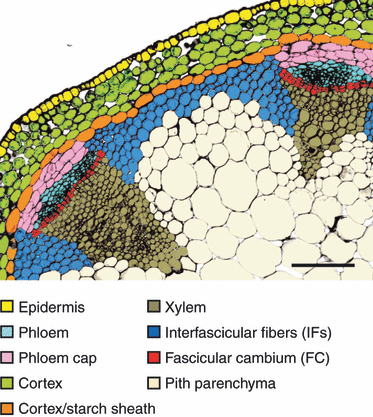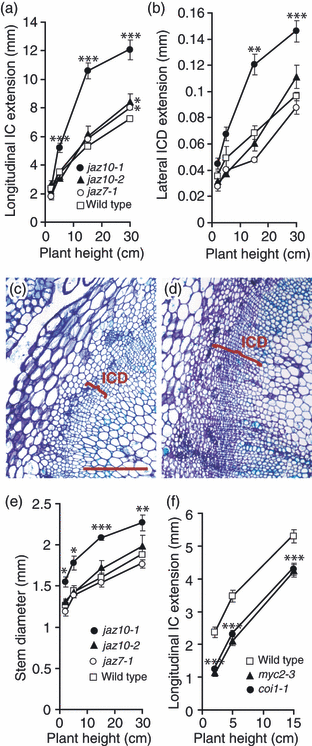Analysis of secondary growth in the Arabidopsis shoot reveals a positive role of jasmonate signalling in cambium formation
- PMID: 20579310
- PMCID: PMC2988407
- DOI: 10.1111/j.1365-313X.2010.04283.x
Analysis of secondary growth in the Arabidopsis shoot reveals a positive role of jasmonate signalling in cambium formation
Abstract
After primary growth, most dicotyledonous plants undergo secondary growth. Secondary growth involves an increase in the diameter of shoots and roots through formation of secondary vascular tissue. A hallmark of secondary growth initiation in shoots of dicotyledonous plants is the initiation of meristematic activity between primary vascular bundles, i.e. in the interfascicular regions. This results in establishment of a cylindrical meristem, namely the vascular cambium. Surprisingly, despite its major implications for plant growth and the accumulation of biomass, the molecular regulation of secondary growth is only poorly understood. Here, we combine histological, molecular and genetic approaches to characterize interfascicular cambium initiation in the Arabidopsis thaliana inflorescence shoot. Using genome-wide transcriptional profiling, we show that stress-related and touch-inducible genes are up-regulated in stem regions where secondary growth takes place. Furthermore, we show that the products of COI1, MYC2, JAZ7 and the touch-inducible gene JAZ10, which are components of the JA signalling pathway, are cambium regulators. The positive effect of JA application on cambium activity confirmed a stimulatory role of JA in secondary growth, and suggests that JA signalling triggers cell divisions in this particular context.
© 2010 The Authors. Journal compilation © 2010 Blackwell Publishing Ltd.
Figures








Similar articles
-
A bHLH-type transcription factor, ABA-INDUCIBLE BHLH-TYPE TRANSCRIPTION FACTOR/JA-ASSOCIATED MYC2-LIKE1, acts as a repressor to negatively regulate jasmonate signaling in arabidopsis.Plant Cell. 2013 May;25(5):1641-56. doi: 10.1105/tpc.113.111112. Epub 2013 May 14. Plant Cell. 2013. PMID: 23673982 Free PMC article.
-
Plant hormone jasmonate prioritizes defense over growth by interfering with gibberellin signaling cascade.Proc Natl Acad Sci U S A. 2012 May 8;109(19):E1192-200. doi: 10.1073/pnas.1201616109. Epub 2012 Apr 23. Proc Natl Acad Sci U S A. 2012. PMID: 22529386 Free PMC article.
-
Negative feedback control of jasmonate signaling by an alternative splice variant of JAZ10.Plant Physiol. 2013 Jun;162(2):1006-17. doi: 10.1104/pp.113.218164. Epub 2013 Apr 30. Plant Physiol. 2013. PMID: 23632853 Free PMC article.
-
Plant oxylipins: COI1/JAZs/MYC2 as the core jasmonic acid-signalling module.FEBS J. 2009 Sep;276(17):4682-92. doi: 10.1111/j.1742-4658.2009.07194.x. Epub 2009 Aug 3. FEBS J. 2009. PMID: 19663905 Review.
-
JAZ repressors and the orchestration of phytohormone crosstalk.Trends Plant Sci. 2012 Jan;17(1):22-31. doi: 10.1016/j.tplants.2011.10.006. Epub 2011 Nov 21. Trends Plant Sci. 2012. PMID: 22112386 Review.
Cited by
-
Functional pleiotropism, diversity, and redundancy of Salvia miltiorrhiza Bunge JAZ family proteins in jasmonate-induced tanshinone and phenolic acid biosynthesis.Hortic Res. 2022 Jul 25;9:uhac166. doi: 10.1093/hr/uhac166. eCollection 2022. Hortic Res. 2022. PMID: 36204204 Free PMC article.
-
A jasmonate ZIM-domain protein NaJAZd regulates floral jasmonic acid levels and counteracts flower abscission in Nicotiana attenuata plants.PLoS One. 2013;8(2):e57868. doi: 10.1371/journal.pone.0057868. Epub 2013 Feb 28. PLoS One. 2013. PMID: 23469091 Free PMC article.
-
Auxin transport and stem vascular reconnection - has our thinking become canalized?Ann Bot. 2019 Feb 15;123(3):429-439. doi: 10.1093/aob/mcy180. Ann Bot. 2019. PMID: 30380009 Free PMC article. Review.
-
Long- and short-distance signaling in the regulation of lateral plant growth.Physiol Plant. 2014 Jun;151(2):134-41. doi: 10.1111/ppl.12103. Epub 2013 Oct 16. Physiol Plant. 2014. PMID: 24053438 Free PMC article. Review.
-
Dissection of the genetic architecture of peduncle vascular bundle-related traits in maize by a genome-wide association study.Plant Biotechnol J. 2022 Jun;20(6):1042-1053. doi: 10.1111/pbi.13782. Epub 2022 Feb 9. Plant Biotechnol J. 2022. PMID: 35080335 Free PMC article.
References
-
- Altamura MM, Possenti M, Matteucci A, Baima S, Ruberti I, Morelli G. Development of the vascular system in the inflorescence stem of Arabidopsis. New Phytol. 2001;151:381–389.
-
- Andersson-Gunneras S, Hellgren JM, Bjorklund S, Regan S, Moritz T, Sundberg B. Asymmetric expression of a poplar ACC oxidase controls ethylene production during gravitational induction of tension wood. Plant J. 2003;34:339–349. - PubMed
-
- Barkoulas M, Hay A, Kougioumoutzi E, Tsiantis M. A developmental framework for dissected leaf formation in the Arabidopsis relative Cardamine hirsuta. Nat. Genet. 2008;40:1136–1141. - PubMed
Publication types
MeSH terms
Substances
Associated data
- Actions
Grants and funding
LinkOut - more resources
Full Text Sources
Other Literature Sources
Molecular Biology Databases

